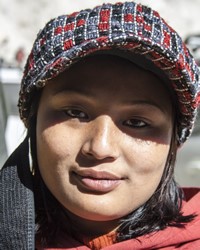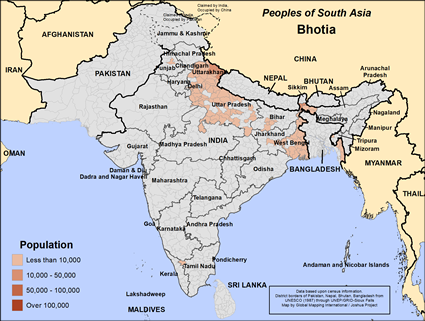Essentially all Buddhist groups in India today are groups who migrated from neighboring Buddhist countries (through choice or to avoid conflict), or who live along the borders with these countries. The Bhotia are the majority people in nearby Bhutan and many live in Nepal as well. In India, they are mainly in Sikkim along the southern slopes of the Himalayas. Bhotia society was feudal in nature; there were serfs and landlords. The serfs and slaves that the Bhotias took were at the bottom of society while the landed aristocracy had the power and wealth.
In most ways, the lifestyles of India's Buddhist peoples are like those of their Hindu counterparts. However, sex roles are unusual for the Bhotia people. Women aren't forced to get married if they are not satisfied with the possible choices of husbands. Men are away for a good percentage of a year, usually on trading expeditions, so their influence on their children is far less than that of the mother. Bhotia women are noted for being competent mothers and home makers.
Descended from Tibetan immigrants, the Bhotia follow a version of Buddhism developed in Tibet that is based on the teachings of the Dalai Lama, blended with the shamanisticc Bon religion.
The majority of Bhotia are Tantrayana (Lamaistic) Buddhists. Lamaistic Buddhism was developed in Tibet and then spread among the Mongols and other minority groups in southwestern Asia. They follow the teachings of the Dalai Lama and believe that each person's well-being was determined by his behavior in previous lives. It is highly influenced by shamanism. They live in fear of their gods and constantly strive to appease them with religious chants, rituals and sacrifices. Like Hindus, Buddhists believe that existence is a continuing cycle of death and rebirth (reincarnation). As long as a person remains within the cycle of death and rebirth, he can never be completely free from pain and suffering. The cycle can only be broken by achieving nirvana, and only those who follow the Buddhist principles of the "middle way" and the "noble eight-fold path" can achieve that state.
The small number of Bhotia believers need discipleship materials to encourage and strengthen them in their Christian walk. They also need the power of the Holy Spirit to take Christ to their neighbors and families.
Pray the hearts of the Bhotia people would be stirred to hunger after God, to drink of living water. Pray for family-based movements to soon transform Bhotia society, blessing them spiritually and economically. Pray for the Lord to move in the hearts of believers to give up their own rights and sacrifice their lives to see the Bhotia people blessed by the work of Jesus Christ, the only Savior.
Scripture Prayers for the Bhotia in India.
| Profile Source: Joshua Project |











